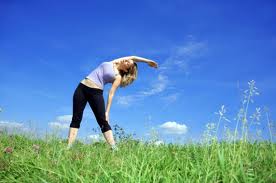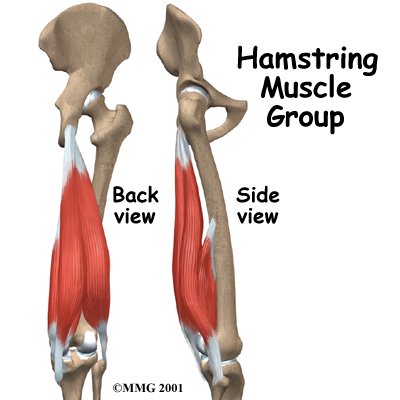Greetings
Get Gardening!

The weather is finally making a sunny, warm change, the tress are in bloom and the grass is getting greener! Are you ready to start planting, mowing the lawn, and pruning the shrubs? Is your body?
The Canadian Physiotherapy Association has some great tips to help you get started with the gardening season, and prevent injuries that may result from this seasonal work. Here are some of their suggestions!
☼ Don't Vegetate, Cultivate!- Did you know that 30 minutes of gardening gives general health benifits similar to a brisk walk? It also helps to increase your endurance and strength!
☼ Get Ready to Go!- Warming up your muscles and joints before you start working will help decrease risk of sprian or strain. See our article below on some stretching tips. Also, be sure to have all the right tools for the job maintained and ready for safe use!
☼ Know Your Limit, Garden Within it- Over working muscles and joints leads to injury, so pace yourself. Take breaks when you are tired, spread heavy lifting and digging tasks over a week, and avoid over-use injuries by doing different activites throughout the day.
☼ Tool Time- Make sure the handle of the tool matches the size of your hand. This will help reduce chance of overuse injury and strain to the muscles. Also, hold your tools with a comfortable grip. Holding too tightly can cause injury.
☼ Posture Makes Perfect...Sense!- Find the "easy zone"- a comfortable posture for your body to work in, and try to do your work in this "zone". If you have to get into an akward position, incorporate a slow, reverse stretch every 15 minutes to reduce strain. Don't forget to lift with your legs, and avoid twisting and reaching!
Featured Question:
How Can Stretching Help Me?

Stretching daily is extremely important for everyone; whether you exercise regularly, participate in sports, or are working around the house. Stretching is the only way to help relax muscles, realign muscle fibers, cool your body temperature and increase flexibility [9]. Unfortunately, most of us do not take the time in our busy routines to stretch, which usually leads to sprains, strains and other injuries. In this article, we will describe different types of stretches, and provide basic guidelines to help you improve your flexibility and well being!
Are There Different Types of Stretches?
There are a number of different types of stretching exercises that can help reduce the risk of injury as well as improve athletic performance [1]. Two of the most known types of stretches are static and dynamic.
Static stretching involves reaching as far as you can, without pain, in one direction and then holding the stretch for 15-60 seconds [2]. This type of stretching is used to increase the length and the flexibility of your muscles. For example, when touching your toes, try to hold it for 30 seconds, as this time frame is the most effective for stretching the hamstrings [3].
Dynamic stretching involves a series of movements that work multiple muscle groups. Controlled body movements gently take you to the limits of your range of motion [4]. The movements do not involve any bouncing or jerking, as lack of control could cause injury. For example, when you want to stretch out your chest, shoulder, back and arms, move your arm and shoulder in slow, controlled, big circles.
Static vs. Dynamic, Which is Better, And When? For years, static stretching was a mainstay in athletic warm-ups because it was thought to prevent injuries and enhance performance. However, new research has shown that dynamic stretching is much better suited for this task since it increases your body and muscle temperature, elongates your muscles and stimulates your nervous system to prepare for the responsiveness that your sport demands [1]. Studies comparing static versus dynamic stretching in pre-athletic warm-ups have shown that dynamic stretching helps prevent injuries and boosts performance better than static stretching [5, 6]. In fact, doing static stretches before a big game or key practice session may actually decrease athletic performance for at least an hour afterward by reducing leg strength and power [7, 8]. Dynamic stretches are also a great way to warm up your body before doing various chores such as gardening, spring-cleaning or washing the car.
Static stretching should still be an important part of your training routine, just not before you workout or play a sport. Instead, static-type stretches should be part of an effective cool-down routine following your activity. By incorporating these stretches, your muscles will have the opportunity to cool down, realign and improve your flexibility!
Does Stretching Help With Injuries?
Stretching plays a central role in physiotherapy treatment for muscle strains and pulls, as well as other musculoskeletal injuries.

When muscles are injured, static stretching is an important and effective part of rehab. For example, hamstring injuries are a common athletic injury, which are treated by physiotherapists. Static stretching plays a major part in the rehabilitation of these injuries because it increases muscle flexibility and relieves pain caused by muscle stiffness [11]. In a clinical trial of 80 athletes with hamstring injuries, those who did a more intense static stretching program took significantly less time to regain their full range of motion [12]. It is important to remember, though, that aggressively stretching an injured muscle will only make things worse, so it is important to wait at least 72 hours before starting gentle stretching exercises, and contact your physiotherapist if you have any questions or concerns.
Adults with tight hamstrings can also benefit from static stretching. Researchers have reported that static stretching is twice as effective as dynamic stretching for increasing flexibility in non-competitive athletes with tight hamstrings [13]. Static hamstring stretching is a great way to decrease risk of injury, and help improve your overall range of motion!
The Bottom Line
Dynamic stretches are best used as a warm-up before exercise, sport or activity to prevent injury and boost performance. They are not helpful when your muscles are already stiff or injured.
Static stretches maximize flexibility and are best used as part of a cool down following physical activity. They also should be used as part of a physiotherapy treatment program for specific muscle injuries.
How I Can Incorporate Stretching? For more information and advice on developing a stretching program that fits your exercise routine and daily activities, contact one of the licensed, trained physiotherapists at Peak Physical Therapy. They will work with you in designing a stretching program that will provide you with the most benefits.
New Articles!
Check it out! We have recently added over 60 new articles to our patient resource library including the following:
Patient Guides:
References:
1. Frederick GA, Szymanski DJ. Baseball (part 1): dynamic flexibility. Strength and Conditioning Journal. 2001;23(1):21-30.
2. American College of Sports Medicine. Position Stand. The recommended quantity and quality of exercise for developing and maintaining cardio respiratory and muscular fitness, and flexibility in healthy adults. Med Sci Sports Exerc. 1998 Jun;30(6):975-91.
3. Bandy WD, Irion JM. The effect of time on static stretch on the flexibility of the hamstring muscles. Phys Ther. 1994 Sep;74(9):845-50.
4. Thacker SB, Gilchrist J, Stroup DF, Kimsey CD Jr. The impact of stretching on sports injury risk: A systematic review of the literature. Med Sci Sports Exerc. 2004;36(3):371-378.
5. Mann D, Jones M. Guidelines to the implementation of a dynamic stretching routine. Strength Cond J. 1999;21(6):53-55.
6. McMillian DJ, Moore JH, Hatler BS, Taylor DC. Dynamic vs. static-stretching warm up: the effect on power and agility performance. J Strength Cond Res. 2006;20(3):492-499.
7. Fowles JR, Sale DG, MacDougall JD. Reduced strength after passive stretch of the human plantar flexors. J Appl Physiol. 2000;89(3):1179-1188.
8. Fletcher IM, Anness R. The acute effects of combined static and dynamic stretch protocols on fifty-meter sprint performance in track-and-field athletes. J Strength Cond Res. 2007;21(3):784-787.
9. Boyle M. Functional Training for Sports. Champaign, IL: Human Kinetics; 2004.
10. Wiktorsson-Moller M, Orberg B, Ekstrand J, Gillquist J. Effects of warming up, massage, and stretching on range of motion and muscle strength in the lower extremity. Am J Sports Med. 1983;11:249-252.
11. Shrier I. Stretching before exercise does not reduce the risk of local muscle injury: a critical review of the clinical and basic science literature. Clin J Sport Med. 1999;4:221-227.
12. Malliaropoulos N, Papalexandris S, Papalada A, Papacostas E. The role of stretching in rehabilitation of hamstring injuries: 80 athletes follow-up. Med Sci Sports Exerc. 2004;36(5):756-759.
13. Bandy WD, Irion JM, Briggler M. The effect of static stretch and dynamic range of motion training on the flexibility of the hamstring muscles. J Orthop Sports Phys Ther. 1998;27(4):295-300.